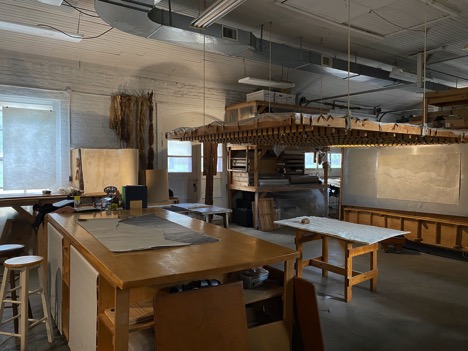By Nicholas Cladis
“A chorus of crickets undulates through green, dewy grass. Crows declare a tree their own, over there, just beyond the field. As I reach down to pull weeds – kusatori – at the base of a kozo tree, spiders retreat from the jumbled root system. I move my hands along the stems of each plant, navigating the bark, removing leaf sprouts before they can become waki-me (side branches). The air is cool, there is shade from a nearby forest, and the tall fences around this plot keep the deer out.
Where am I? This has been a question I’ve asked myself multiple times over the last year. Mid-pandemic, I returned to the US from six years of living and working in Fukui Prefecture, Japan. While there, I became intimately connected to the Echizen papermaking community, and now consider many there to be friends and family, teachers and colleagues. The decision to change my life so dramatically was not taken lightly, but a year later, I can confidently declare that it was the move I needed to make. As a papermaker, and a papermaking artist, I receive so much joy from teaching and collaborating with others. That is exactly what I returned to do as faculty at the University of Iowa Center for the Book.
So, I repeat: Where am I? The first paragraph could be describing Echizen, where I learned how to cultivate kozo. Or, it could be Iowa, where I teach topics ranging from nagashizuki to sculptural papermaking. When I first stepped foot in our kozo plot at the UICB paper research facility, the smells and sights took me right back to the mountain valley where I had so often tended to trees or participated in a harvest. It was not just the fact that my new position included a kozo plot to care for, but also that caring for it and making paper from it brought forth so much wisdom from the craftspeople and artists who had taught me: Masuda Yoriyasu, Murata Naho, Uesaka Kazuo, Kato Shizuko, Iwano Ichibei, Osada Kazuya and Eiko – naming all who taught me may be impossible, but naming who I can is important.
This, perhaps, encapsulates the UICB nicely: we are a center of analog sleuths, searching the past for ways to express the present and make our way into the future. We do not just teach and repeat our learned techniques, but also advocate for personalized art-making.

A lot has happened since coming to Iowa. I received two grants, which are enabling the UICB to plan for the future: one grant to bring a group of graduate students to Echizen, and another to bring two craftspeople from Echizen to Iowa. We’ve connected the Center and Echizen through events, as well. Students submitted films which were displayed on large handmade washi sheets as part of the exhibition of contemporary paper art in Echizen. Then last spring, we even held a Japanese papermaking festival in Iowa in honor of the papermaking goddess Kawakami Gozen.
I learned about washi from a circle of experts who I will always be indebted to. Equipped with their lessons, and having picked up several of my own along the way, my approach to teaching papermaking emphasizes community. It isn’t enough to learn how to harvest the kozo – I also teach about growing it, empowering students to be well-versed in the full cycle of the material. We work together to prune, weed, and fertilize, and later in the fall, just as we did last fall, we will harvest the trees, strip the bark, and feast on steamed sweet potatoes. I also teach my students about who taught me (in the case of kozo cultivation and care, the wonderful Kato Shizuko, who told me, “Every year I learn something new.”). In this way, we at the UICB continue cycles, create new links in an ongoing chain, and acknowledge that nothing exists in a vacuum.
For a while, the US had a washi issue. Many thought it was rice paper, and Hiromi, among others, has been making strides to educate the public. Now there is another issue, though: the idea that washi is a singular craft with a singular identity. Japanese paper is a discipline, and like any other discipline, it has range. I like to think about washi as if it is music. There is classical music, the traditional washi we all know and love. But there is also punk rock, wherein the maker pulp-paints on massive screens, weaves lace-like tapestries, turns paper into clothing, pours slurry directly onto sandy shores, or fills a room with a world of fiber.

At the UI Center for the Book, I am part of a collective of colleagues and students who investigate craft and art with an eye for the details, and another eye for the concepts. I have once again found a place to belong, a community that has drawn me in, and encouraged me to never forget the community I came from.
NOTE 1: If you would like to help promote the craft and art of papermaking, and the other book arts, at the UI Center for the Book, please learn about their almost complete $2.5million challenge grant by clicking here.
NOTE 2: If you are interested in receiving an MFA or certificate in the book arts from the UI Center for the Book, click here.“
Thanks Nicholas!





